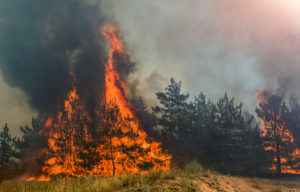Basics of Wildland Fire
When it comes to protecting your land from a wildland fire, you need to understand more about the natural situation heading your way. It’s important to understand how fires start, and what they need to keep burning.
Wildland fires are natural. They start on their own, and they even have a place in the lifecycle of forests and woodland. It’s all about the “fire triangle.”
What is the Fire Triangle?
Wildfires will move fast in the direction of where there’s the most supply of the elements they need. The elements make up the fire triangle, so to control the fires, the triangle needs to collapse. This is how firefighters work to put out the fires.
Heat, fuel, and oxygen make up the wildfire. Of course, it’s impossible to get rid of the oxygen in the air, so the heat and fuel are the two elements that firefighters will battle to control to collapse the triangle.
Heat Creates the Spark
Heat is the spark of the fire. Without heat, the spark can’t start and the wildfire won’t happen. There are some elements of heat we can’t get rid of, such as natural heat in the summer. However, most wildfires are now started due to human problems. These include unattended campfires, discarded cigarettes, and even falling powerlines.
That being said, lightning can cause fires. “Dry lightning” is common in the western United States, and it can transfer energy without rain. Without the moisture from the rain, the lightning starts the spark needed for the fire.
Once the fire starts, it will spread in two phases. The first is upward to the aerial fuels like tree branches. After that, the fire spreads sideways. If the heat is so intense, the fuel can ignite before flames reach it.
Fuel Spreads the Fire
The next part of the triangle is fuel. This is just anything that can help to spread the fire, and it can include natural elements like dry grass and twigs. It can even include branches and trees, with dead or diseased trees being the most problematic for spreading fires.
It’s not possible to remove all fuels, but firefighters will try to remove some. And housing developments are created with the fuel in mind. There will be buffer zones to help reduce the risk of the fire spreading.
Oxygen to Help the Fire Breathe
Like humans, fire needs oxygen. It will burn the oxygen to spread the fire. This is the impossible element to stop because it is in our air.
However, firefighters will use CO2 fire extinguishers to help displace the oxygen to put out the fire. The displacement is only temporary. Water can also help to put out the fire. While it does have some oxygen in its makeup, the water helps to douse the heat.
By understanding the makeup of the fire, it’s easier to put it out. It’s also important to understand how to avoid all fires in the area.
If you need help creating defensible area around your house, give us a call at (719)400-9104.

